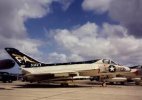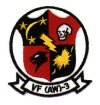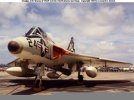-
Please take a moment and update your account profile. If you have an updated account profile with basic information on why you are on Air Warriors it will help other people respond to your posts. How do you update your profile you ask?
Go here:
Edit Account Details and Profile
You are using an out of date browser. It may not display this or other websites correctly.
You should upgrade or use an alternative browser.
You should upgrade or use an alternative browser.
Stupid Questions about Naval Aviation (Part 3)
- Thread starter Top_Gun_1_0_1
- Start date
I believe it is used to designate all weather strike capability. For instance, when Marines had A-6s and A-4s, the A-6s were all weather but the A-4s were basically VFR bombers.
Aha, I sort of guessed something like that. The "tactical AW" capability. Thanks.
Concur...probably a lot of legacy/heritage nomenclature there as well. Maybe (AW) now more accurately means (Add WSO).So I don't see how they are any more "all weather attack" than single seat.

FlyingOnFumes
Nobel WAR Prize Aspirant
Concur...probably a lot of legacy/heritage nomenclature there as well. Maybe (AW) now more accurately means (Add WSO).
What I read was the (AW) designation was introduced with when the Marine Corps transitioned from the "Scooter' (A-4 Skyhawk) to the A-6 Intruder, with it's RADAR and TRAM (Target Recognition and Attack Multi-Sensor) system that gave it the ability to bomb through IMC.
The F/A-18Ds replaced the A-6s, but in the FastFAC / FAC(A) role (just as the two-seat "F" model "Rhinos" did in the Navy with the F-14), which is why the (AW) squadron designation carried over.
It is still a weird distinction. The only difference is that they have two seats in (AW) squadrons.....the equipment is otherwise the same when compared to their VMFA counterparts. So I don't see how they are any more "all weather attack" than single seat.
My guess would be that with earlier generation sensors it was probably considered infeasible for a single seat guy to work a radar air to surface attack timeline in the goo by himself. This timeline is still published (not sure why) in one of our pubs, and just reading it sounds like you need all your shit in one sock when it comes to radar mechanics.
An APG-65 expand map with a designation + Mk82s + rudimentary GPS/INS combo in a dive out of the clouds is not my idea of a good time when considering some of the more modern options that are available to us.
The "AW" designation goes back earlier than that...radar-equipped aircraft (starting with Corsairs, I think, in the Marine Corps) were originally designated VF(N) or VMF(N) for night interceptor capability. That then became (AW), over time, for other T/S/S aircraft upgrades. Here's one example:What I read was the (AW) designation was introduced with when the Marine Corps transitioned from the "Scooter' (A-4 Skyhawk) to the A-6 Intruder, with it's RADAR and TRAM (Target Recognition and Attack Multi-Sensor) system that gave it the ability to bomb through IMC.
The F/A-18Ds replaced the A-6s, but in the FastFAC / FAC(A) role (just as the two-seat "F" model "Rhinos" did in the Navy with the F-14), which is why the (AW) squadron designation carried over.
The “Death Dealers” were again redesignated on May 1, 1957 as Marine All-Weather Fighter Squadron 114 (VMF(AW)-114) and transitioned to the F9F-8 Cougar and then to the F4D Skyray.
Thinkin' it meant different IMC capabilities in different eras, dependent upon Squadron mission. I believe the first Navy jet (AW) Squadron was VF(AW)-3. From 1958-63, assigned F-4D "Skyrays". Based at NAS North Island and assigned to NORAD, their mission included 'quick response air defense of the CONUS west coast from Mexico north including Alaska. What made them AW capable was their APG-50A radar.So, not sure if this has been asked before, but what's with the (AW) designation for hornet squadrons (and others?). My understanding is it's "all weather", but what the hell does that mean?

When I was in advanced in F9F-8s at Beeville, my hope was to get orders to a 'Ford' Squadron, but alas, I got orders to Furys. A preflight buddy of mine who winged at Memphis at the same time, was ordered to VF(AW-3), and at the time I was envious. Turns out he only got 5-10 hrs p/m (not in the F-4D), as his unit didn't want Nuggets flying their Fords. Thank the Lord I didn't get those orders! After that year he requested a transfer, ending up as a Whidbey 'Whale' Driver!


BzB
Attachments
FlyingOnFumes
Nobel WAR Prize Aspirant
Thinkin' it meant different IMC capabilities in different eras, dependent upon Squadron mission. I believe the first Navy jet (AW) Squadron was VF(AW)-3. From 1958-63, assigned F-4D "Skyrays". Based at NAS North Island and assigned to NORAD, their mission included 'quick response air defense of the CONUS west coast from Mexico north including Alaska. What made them AW capable was their APG-50A radar.
View attachment 11685
When I was in advanced in F9F-8s at Beeville, my hope was to get orders to a 'Ford' Squadron, but alas, I got orders to Furys. A preflight buddy of mine who winged at Memphis at the same time, was ordered to VF(AW-3), and at the time I was envious. Turns out he only got 5-10 hrs p/m (not in the F-4D), as his unit didn't want Nuggets flying their Fords. Thank the Lord I didn't get those orders! After that year he requested a transfer, ending up as a Whidbey 'Whale' Driver!
View attachment 11684
BzB
Where is the "Ford" logo on that F4D?

They are for pulling your legs out from under the insterment panel during an ejection. I didn't know that they were used on the Tomcat. The F-104 had them and the pilots wore spurs that they were attached to.Was reading a book about an F-14 crew and they mentioned wearing Leg Restraints; what are the leg restraints and how do they work?
707guy
"You can't make this shit up..."
They are for pulling your legs out from under the insterment panel during an ejection. I didn't know that they were used on the Tomcat. The F-104 had them and the pilots wore spurs that they were attached to.
Ah...no way...I thought they were for keeping your socks up and your shirt tucked in...

I wore them in both the F-4 and the F-14...slightly different configurations and leg placement...but, as jmcquate said...they snugged up your lower legs as the seat went up the rails both to prevent "flailing injuries" and impact with the instrument panel as you trusted your life to Martin-Baker. Interestingly, the only injury (if you could call it that) I experienced in my ejection was soreness in my calf muscles, and a nice "gouge" in the toes of both of my flight boots. Guess I didn't quite clear the panel as I'd hoped, and got a mild "hyperextension" of some leg muscles. Beat the alternative...They are for pulling your legs out from under the insterment panel during an ejection. I didn't know that they were used on the Tomcat. The F-104 had them and the pilots wore spurs that they were attached to.
Need some "Old RIO" help here...but my memory chip says F-4 restraints remained in the cockpit, and were donned as you manned up. F-14 restraints were personally issued, and donned as you "geared up"...with just the "lower leg" clip to be attached as you manned up and strapped in. That could be ALL wrong...

